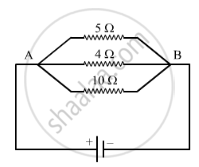Advertisements
Advertisements
प्रश्न
Two bulbs are marked 100 W, 220 V and 60 W, 110 V. Calculate the ratio of their resistances.
उत्तर
Given Ist Bulb
P1 = 100 W
V1 = 220 V
IInd Bulb
P2 = 60 W
V2 = 110V
We know P = `"V"^2/"R"`
So R = `"V"^2/"P"`
So `"R"_1/"R"_2 = ("V"_1^2/"P"_1)/("V"_2^2/"P"_2)`
`= ("V"_1^2 xx "P"_2)/("P"_1 xx "V"_2^2)`
`= (220^2 xx 60)/(100 xx 110 xx 110) = 2.4`
APPEARS IN
संबंधित प्रश्न
What do the letters p.d. stand for?
What is a voltmeter?
A potential difference of 20 volts is applied across the ends of a resistance of 5 ohms. What current will flow in the resistance?
What p.d. is needed to send a current of 6 A through an electrical appliance having a resistance of 40 Ω?
The values of potential difference V applies across a resistor and the corresponding values of current I flowing in the resistor are given below:
| Potential differences, V (in volts) | : | 2.5 | 5.0 | 10.0 | 15.0 | 20.0 | 25.0 |
| Current, I (in amperes) | : | 0.1 | 0.2 | 0.4 | 0.6 | 0.8 | 1.0 |
For the circuit shown in the diagram below:

What is the value of:
(i) current through 6 Ω resistor?
(ii) potential difference across 12 Ω resistor?
In the circuit diagram given below, the current flowing across 5 ohm resistor is 1 amp. Find the current flowing through the other two resistors.

Calculate the current flowing through each of the resistors A and B in the circuit shown in the following figure.

Find out the following in the electric circuit given in Figure
- Effective resistance of two 8 Ω resistors in the combination
- Current flowing through 4 Ω resistor
- Potential difference across 4 Ω resistance
- Power dissipated in 4 Ω resistor
- Difference in ammeter readings, if any.

What does the positive and negative sign of potential convey?
